Seven common home temperature controller types and intelligent temperature controller introduction
In todays home environment, the appropriate temperature control is not only related to the comfort of living, but also directly affects the energy consumption and economic benefits. From floor heating to central air conditioning, different thermostats play a core role, helping us to keep the indoor temperature constant and comfortable in the four seasons. With the development of technology, many types of temperature controllers have appeared on the market, each with its own unique functions and applicable scenarios. This article will introduce seven common thermostat at home through detailed tables and analysis to help you understand the characteristics and applications of each thermostat, so as to make a more appropriate choice.
Overview of temperature controller
In order to more intuitively show the basic information and main functions of different thermostats, we first compare the seven common home thermostats through a table.
Table 1: Comparison of thermostat type and function
Temperature controller type | major function | Recommended use environment |
Floor heating temperature controller | Control the ground heating system to provide uniform indoor heating. | Houses, offices, and especially families in cold areas. |
Heat pump temperature controller | Control of the heat pump heating and cooling, highly efficient energy use. | Areas with distinct variable seasons. |
Electric heating temperature controller | Manage the temperature of the electric heater or the electric floor heating. | Any small space that requires rapid heating. |
Central air-conditioning thermostat controller | Adjust the heating and cooling system of the whole building. | Large residential buildings or commercial buildings. |
Water heater thermostat | Control the water heating equipment to ensure a constant water temperature. | Families, hotels, or other places that require lots of hot water. |
Solar water heater thermostat controller | Manage solar hot water systems and optimize energy absorption and conversion efficiency. | Environmental awareness, sunny areas. |
Fresh air temperature controller | Control the fresh air system and adjust the temperature and quality of the air entering the room. | High-density residential areas, environments that require constant fresh air supply. |
Through this table, we can have a preliminary understanding of the main functions and applicable environment of each thermostat. Next, we will introduce the specific characteristics and application mode of each kind of thermostat in detail.
detailed introduction
1. Floor heating temperature controller
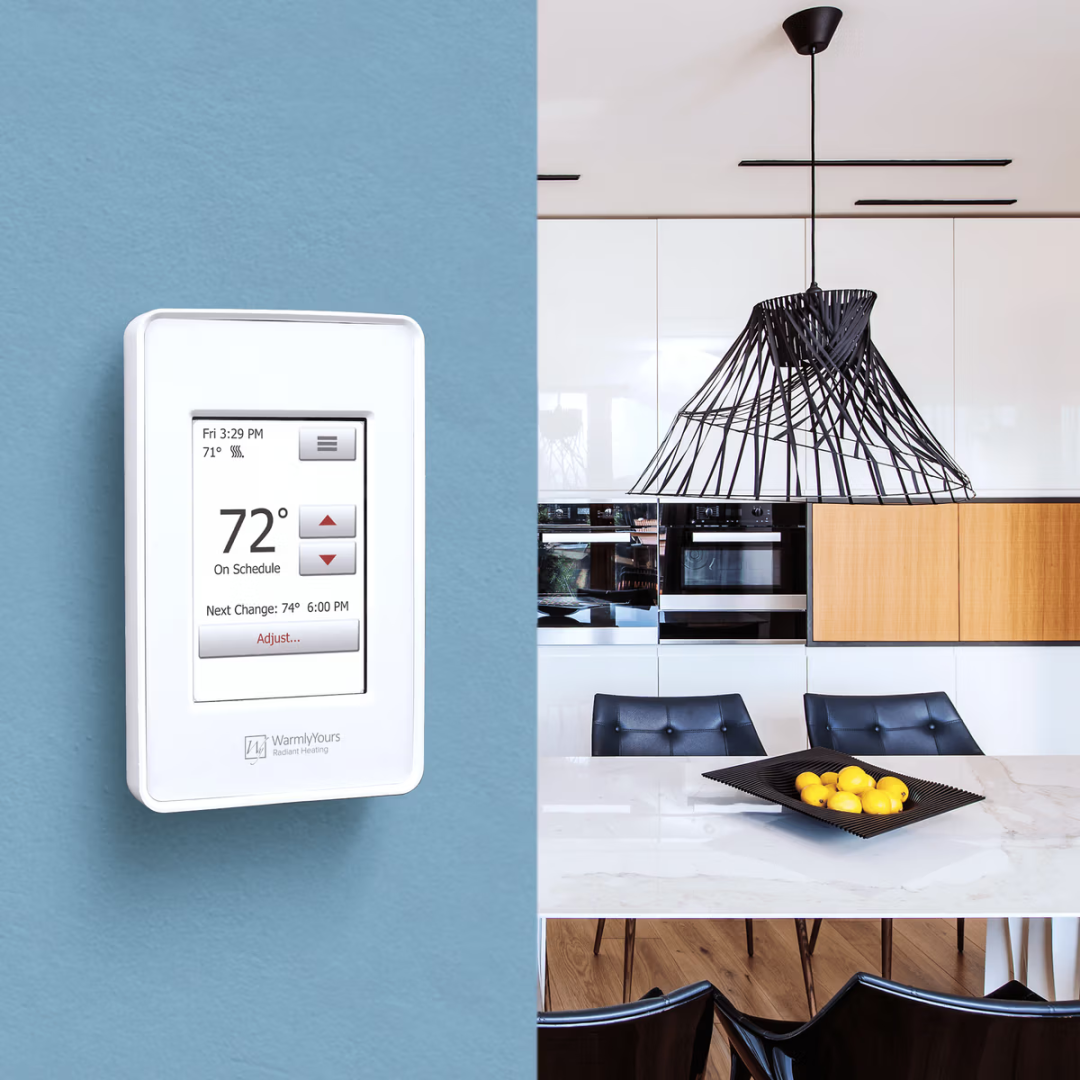
Introduction and function: The floor heating temperature controller is designed to control the floor heating system equipment, it monitors the indoor temperature through the temperature sensor, and adjusts the output of the floor heating, to ensure that the ground temperature is uniform and in line with the set comfort level. The heat provided by the floor heating system rises uniformly from the ground by radiation, increasing the thermal efficiency and reducing the flow of dust in the air, which is a big advantage for people sensitive to the respiratory system.
Conventional use: In residential and commercial real estate, floor heating thermostats are usually used in major living areas such as living rooms, bedrooms and bathrooms, providing continuous and comfortable heat. Users can set a daily or weekly heating schedule based on their lifestyle habits to maximize energy efficiency.
Next, we will continue to introduce in detail the remaining six common home thermostats, their functions, routine use and characteristics.
2. Heat pump temperature controller
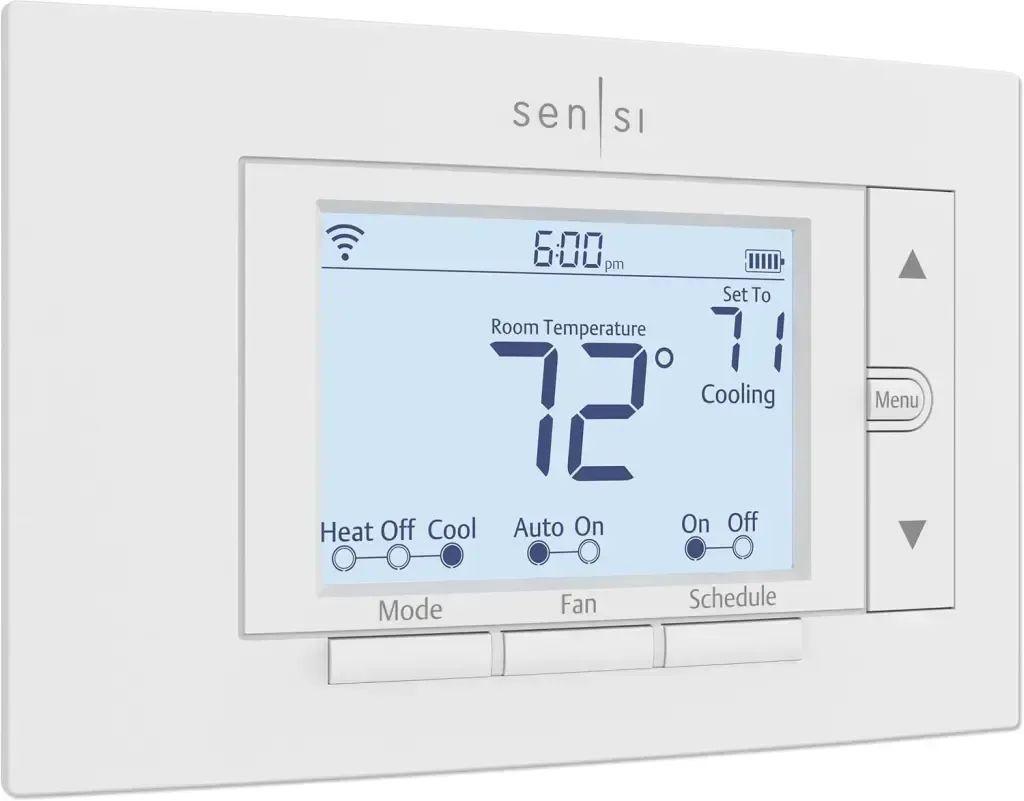
Introduction and function: The heat pump temperature controller is used to control the heat pump system, which can provide heating and cooling functions at the same time, and is very suitable for the areas with large temperature changes in the four seasons. Heat pump thermostat can optimize the operation of heat pump, improve energy efficiency and reduce energy consumption.
Conventional use: Heat pump thermostats are usually installed in residential or commercial buildings that require year-round temperature regulation. Users can set the temperature threshold to ensure that the indoor temperature remains comfortable no matter how the external temperature changes.
3. Electric heating temperature controller
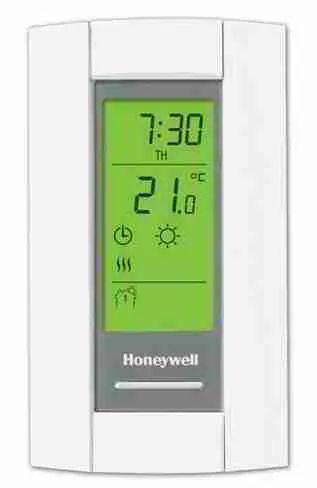
Introduction and function: the electric heating temperature controller is used to control the electric heating equipment, such as the electric radiator or the electric heating floor. This type of thermostat can accurately adjust the output of the electric heating equipment to maintain a stable indoor temperature.
Routine use: in the home or office, the electric heating temperature controller is suitable for fast heating small space. The user can adjust the temperature as needed, or set a timing procedure to automatically turn the heating on or off at a specific time.
4. Central air-conditioning temperature controller
Introduction and function: Central air conditioning thermostat is used to manage the central air conditioning system and control the heating and cooling of the whole building or house. This thermostat can achieve complex multi-region temperature control and improve the overall energy efficiency.
Conventional use: the central air conditioning thermostat is usually installed in large residential or commercial buildings, by setting up different areas or floors with different temperature requirements, to achieve refined temperature control.
5. Water heater and temperature controller
Introduction and function: Water heater temperature controller is used to control the operation of the water heater to ensure constant water temperature and avoid energy waste. The thermostat accurately adjusts the temperature of the water heater and is suitable for homes, hotels, or other places requiring large amounts of hot water.
Routine use: Users can set the water temperature according to their personal preferences and needs, and the water heater thermostat can also set a specific heating schedule to save energy and provide hot water when needed.
6. Solar water heater thermostat controller
Introduction and function: The solar water heater temperature controller is used to manage the temperature exchange between the solar heat collector panel and the water storage tank. It optimizes energy absorption and conversion to maximize system efficiency while preventing overheating.
Conventional use: In sunny areas, the solar water heater temperature controller can automatically adjust the production of hot water according to the intensity of the solar radiation, to ensure the continuous supply of efficient and environmentally friendly hot water.
7. Fresh air temperature controller
Introduction and function: Fresh air temperature controller is used to control the operation of fresh air systems, which are responsible for introducing the treated fresh air into the room. It can adjust the temperature of indoor air, improve air quality and provide a healthy and comfortable environment for the living space.
Conventional use: the fresh air temperature controller is particularly important in high-density residential areas or industrial environment. It can automatically adjust the intake volume according to the difference between external and internal temperature to ensure that the indoor air is fresh and the temperature is suitable.
These detailed introductions provide specific information and use guidelines for various thermostat to help users to choose the most appropriate thermostat according to their actual needs and living environment. The next section will involve more discussion of international specifications and standards to ensure that these devices can be used safely and effectively by users worldwide.
Wiring mode and control strategy
Next, we will detail the wiring methods and control strategies of various thermostats through another table to ensure that you can choose the most suitable configuration according to the specific needs of your home.
Table 2: wiring mode and control strategy
In this part, we will detail the wiring mode of various thermostats and their control strategies through tables, which is crucial to ensure the correct installation and optimal performance of the equipment.
Temperature controller type | mode of connection | control strategy |
Floor heating temperature controller | Usually contains the power cord, ground wire and control line, connected to the power supply and control end of the floor heating system. | Temperature difference control, PID control, programmable, and intelligent learning functions |
Heat pump temperature controller | Connecting to the power and control ends of the heat pump, a multiline system may be required to support heating and cooling functions. | Temperature difference control, time program control, intelligent adjustment |
Electric heating temperature controller | Simple two-or three-wire system that directly control the electric heating element. | Temperature difference control, timing control, some models support remote control |
Central air-conditioning thermostat controller | Complex multi-line system that needs to be connected to all parts of the central air conditioning. | Area control, combined control of temperature and humidity, intelligent and remote control |
Water heater thermostat | At least two wires are connected to control the heater power switch. | Temperature difference control, energy efficiency optimization control |
Solar water heater thermostat controller | Including temperature sensor lines, power lines, and control lines to optimize solar energy collection and use. | Temperature priority control, energy efficiency monitoring, automatic adjustment |
Fresh air temperature controller | Usually need to be connected with the indoor and outdoor temperature sensors and fresh air units. | According to the indoor and outdoor temperature difference, automatic adjustment, timing control, air quality feedback control |
Through this table, we can see the differences in the wiring modes and control strategies of different types of thermostats, which directly affect the installation process and the daily operation efficiency of the equipment.
International specifications and standards
For thermostats used in transnational and international markets, it is extremely important to understand and comply with the electrical specifications and safety standards in different countries and regions. Below is a table that outlines the specification differences and wiring standards for some of the major markets.
Table 3: Specification and wiring standards of different countries and regions
Country / region | Voltage and frequency requirements | Regulation and certification | Special wiring requirements |
America | 120V/60Hz | UL certification, NEC electrical code | Strict requirements for grounding and protection measures |
EU | 220-240V/50Hz | CE marking, and RoHS compliance | Must comply with the EUs low voltage directive and the electromagnetic compatibility directive |
China | 220V/50Hz | CCC attestation | Must accommodate the needs of high population density and high frequency of use |
Japan | At 100V / 50Hz or 60Hz | PSE attestation | There are specific shock-proof and fire-resistant standard requirements |
Australia | 230V/50Hz | SAA attestation | Outdoor climate effects such as waterproofing and UV resistance should be considered when installation |
This table shows some of the key electrical and safety standards to consider when operating in a global market, helping manufacturers and users ensure compatibility and safety of products.
Intelligent control mode: the innovation of modern temperature controller
With the continuous progress of technology, the popularity of smart home systems has greatly changed the way we manage home devices, and thermostats are no exception. Intelligent control makes the temperature controller not just a simple temperature control device, but an intelligent system that can improve energy efficiency, increase comfort and simplify daily life. This section explores the control methods of smart thermostats and their benefits.
Basic characteristics of the intelligent temperature controller
The main difference between intelligent thermostat and traditional thermostat is its connectivity and automation function. These thermostats are typically connected to the home network via Wi-Fi or other wireless technology (such as Zigbee or Z-Wave), where users can remotely control the temperature in their home through a smartphone app, tablet, or voice assistant (such as Amazon Alexa, Google Assistant, or Apple HomeKit).
Main intelligent control function
1. Remote control: Users can view and adjust the temperature settings in their home anywhere through the app, whether in the office or on vacation.
2. Automatic scheduling: The intelligent temperature controller can automatically set the temperature scheduling according to the users daily activity mode. For example, it can automatically start heating your home before you usually get up, ensuring that your room is warm and comfortable when you get up.
3. Energy efficiency analysis: Many smart thermostats provide detailed energy consumption reports and analyses to help users understand how their heating and cooling habits affect energy consumption and how to adjust Settings to reduce energy costs.
4. Geofence: Using the users smartphone location, the smart thermostat can know when the user leaves home or on the way home. The system adjusts the temperature accordingly to ensure optimal energy efficiency and to provide a comfortable environment when the user gets home.
5. Voice control: Integrated with a smart home assistant, users can simply use voice commands to adjust the temperature settings, greatly increasing convenience and accessibility.
6. Learning preferences: Some high-end smart thermostats, such as Nest Learning Thermostat, have the ability to learn user preferences and build a suitable temperature schedule for a few days without much user intervention.
The practical application of the intelligent temperature controller
Given the potential of smart thermostats to improve energy efficiency and user comfort, many modern homes and offices have begun to deploy these devices. For example, a home may use an intelligent floor heating thermostat to warm up the room, while in summer a central air conditioning thermostat to optimize cooling efficiency.
The integration and application of smart thermostats not only improves the comfort of living and working environments, but also helps to achieve a more sustainable lifestyle, reducing energy waste through precise control and intelligent regulation. With the continuous progress of technology and increasing user awareness, it is expected that smart thermostats will become an important part of home automation in the future.
Energy-saving effect and index data of intelligent temperature controller
Smart thermostats not only improve the comfort and convenience of homes, they also play an important role in energy saving and reducing environmental impacts. With smart features, these devices can optimize the heating and cooling time and reduce unnecessary energy consumption, thus bringing significant energy saving effects for users. This section will discuss the energy saving effect of the smart thermostat, and provide some specific energy saving data.
Energy saving characteristics
1. Automatic regulation: The intelligent temperature controller can automatically adjust the setting according to the outdoor temperature and indoor activity mode to avoid excessive heating or excessive cooling, which directly reduces the waste of energy.
2. Efficient scheduling: By learning user habits, intelligent thermostats can automatically create efficient heating and cooling schedules. For example, automatically reduce the operation of heating or air conditioning when the user is usually not at home.
3. Details optimization: The smart thermostat can also save energy by slightly adjusting the temperature settings (such as reducing 1-2°F / about 0.5-1°C), and such small changes usually do not affect the comfort of the residents.
Index of energy-saving data
The energy-saving effect of the intelligent thermostat can be more clearly reflected by the following data:
· Reduction in energy consumption:
It is estimated that smart thermostats can reduce home energy use by about 10% to 12%.
· Annual savings:
On average, homes can save about 10 to 23 percent of heating costs and 15 percent of air-conditioning costs each year by using smart thermostats.
· Long-term ROI:
While the initial investment in smart thermostats is relatively high, according to the US Environmental Protection Agency (EPA), the average home can recover the cost within two years.
These data illustrate that while smart thermostats are more expensive than conventional thermostats, they can be cost-effective in the long term by significantly reducing energy costs. More importantly, this type of thermostat helps the home to achieve more effective management and use of energy through automation and intelligent functions.
Sum up
Intelligent thermostat not only improves the convenience and comfort of our life, its energy-saving characteristics also help to promote the family to a greener, more sustainable direction. With the continuous progress of technology, the market for smart thermostats is expected to be further expanded, and their energy-saving technologies will continue to improve, making a greater contribution to the improvement of global energy efficiency.
The correct selection and installation of temperature controllers is crucial to improve the comfort and energy efficiency of the home and office environment. Through the introduction and analysis of this paper, I hope that you can better understand the functions, applicable scenarios, wiring methods and international specification differences of various temperature controllers, so as to choose the most suitable temperature controller for their needs. In todays deepening globalization, the correct selection and use of these devices can not only improve the energy efficiency of individuals and enterprises, but also ensure compliance with local regulations and standards, and achieve safe and efficient environmental control.
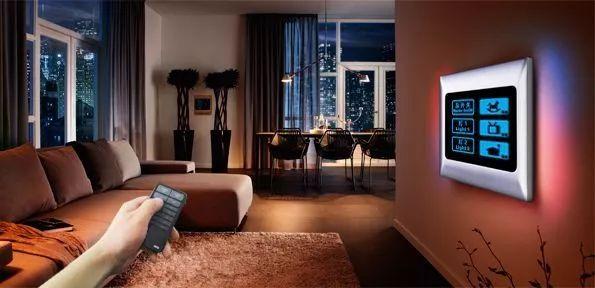 The smart home six systems hel
The smart home six systems hel
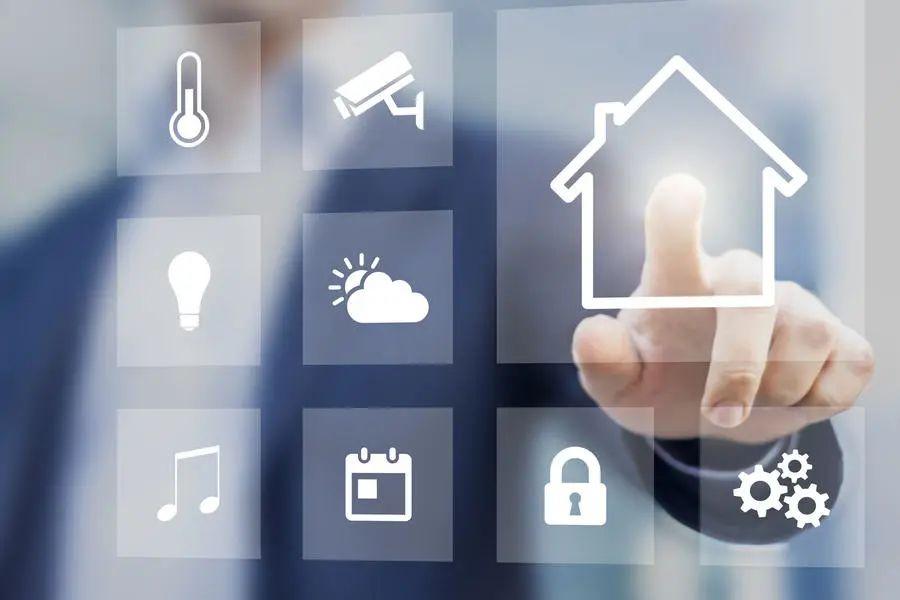 Panorama combing of the smart
Panorama combing of the smart
 The Internet of Things: the bi
The Internet of Things: the bi
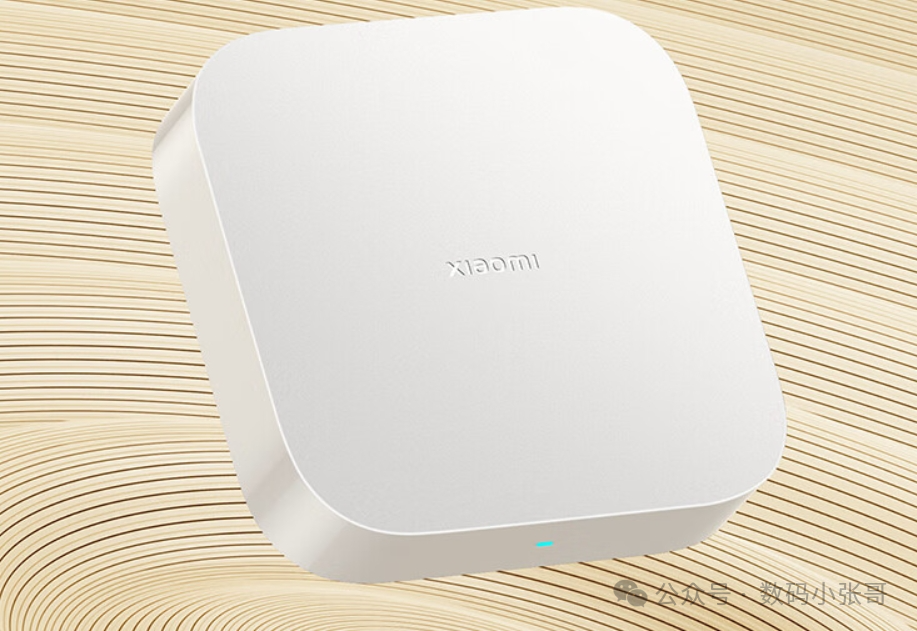 What is a smart gateway, and w
What is a smart gateway, and w
